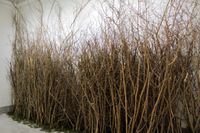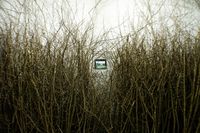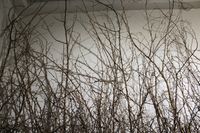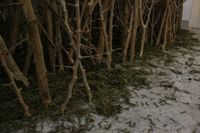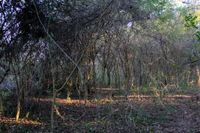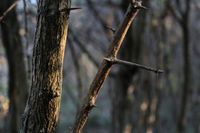PAISAJE A DESTIEMPO
LANDSCAPE AT THE WRONG TIME
Video-Installation
2019
5.60W x 3.50H Mtr
Branches of Dchrostachys cinerea (Marabú) and a tablet.
Paisaje a destiempo transplanted two panoramas of the interior of Cuba, a rural landscape and an urban one as a window (on a tablet). A marabou plantation was inserted in its entirety in the gallery environment as a span containing a platform that connects us with the ways of life of small cities: (Minas) as a partially slowed down and visually monotonous scenario as well as the vegetation that surrounds it.
This video-installation completely intervened a wall of the exhibition space. The branches, trunks and leaves of this invasive plant will become a grafted mattress on the white wall of the gallery. In the center of it, a looping video will be shown, like an indentation in the heart of this forest that is brought from afar.
I was interested in invading the gallery with this internal reality of the country, as a complementary space. I sought to bring out the invariability of the local Minas Gerais panorama (urban-rural) within the artistic consumerism. My scenario is Minas, one of the poorest municipalities of Camagüey. This is one of the images that evidences the lack of productivity in Cuba, the little sense of progress, it is lived in pause or it is produced from the "invention". We all simply assume this landscape as an identity motif.
I took urban landscape shots, scenes of the daily life of the place, the life in the street, the deserted noons, the nights full of young people on the wifi. The video shows the point where the daily life of the municipality is mixed with national production. It is a portrait of the local and family economy, where the productive states, its rhythm and its repercussion on the country's performance are evidenced.
Life starts very early in the morning and ends before nightfall. The chores are repeated every day and always in the same order for as long as I can remember. Throughout my short life I observed how the production of the land was decreasing, and the prices of its products were rising in an almost capitalistic measure. The further I moved away from the daily life of the area, both in time and distance, the greater the changes I saw in the landscape. Along the roadsides I could only glimpse a cordon of a single species of vegetation. This one, both usurper and protector of the land, blurs my vision because it limits my possibilities of seeing another horizon.
The marabou has become an endemic problem, and it is no secret to even the most city dweller that Cuba is a huge marbuzal. It replaces almost all the areas of other crops on Cuban soil until today, especially if we include the large extensions of land belonging to the sugar mills dismantled by the government. The sugar cane areas of the entire northern region of Camagüey are almost paralyzed with plants more than thirty years old in the most intricate spaces.
This invasive species - bush - coming from Africa for various reasons, after a setback in forestry control measures. In recent years there has been a disproportionate advance of this plant, occupying almost 50% of the agricultural area of the country.
It is said that it was through this province that the marabou was introduced in Cuba, brought from Africa on slave ships in the stomachs of cattle from these lands. It is even attributed a legend in which it is considered that it was introduced as a decoration to the province.13 We believe that if this story is true, it overfulfilled the objective, since it is an exquisite decoration in the whole country that shows the statism and the lack of interest towards the promotion of a sustainable internal infrastructure.
Monotonous and with a slow evolution, our landscape influences those who inhabit it, psychologically the environment conditions us and transmits us part of its natural state. We can see that the emotional transmission that is given from the marabou to the country, has been planting generations of hard bark, not of pine, but of thorns, for several decades.
1 "Cuban Forestry Situation" Technical Information Bulletin No. 257. January-February, 2009. p. 75.

